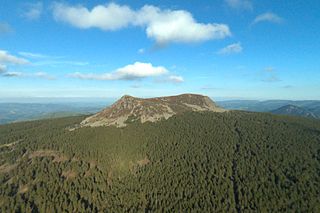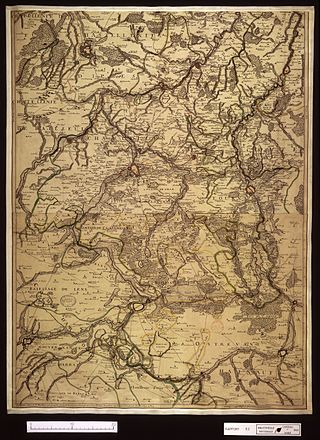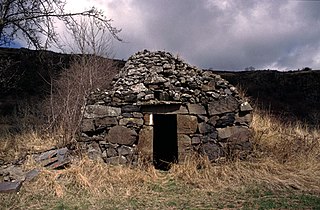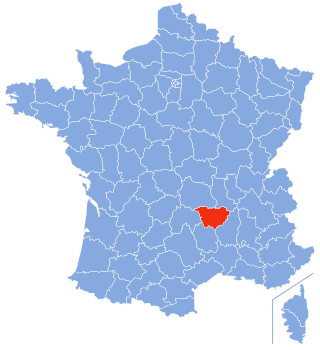Related Research Articles

Haute-Loire is a landlocked department in the Auvergne-Rhône-Alpes region of south-central France. Named after the Loire River, it is surrounded by the departments of Loire, Ardèche, Lozère, Cantal and Puy-de-Dôme. In 2019, it had a population of 227,570; its inhabitants are called Altiligériens in French.

A castellania was the smallest administrative subdivision of land in medieval Malta, Poland, Hungary and the Netherlands, signifying the territory over which the master of a castle exercised his ordinary rights. At its centre was the castle, the most important place in the castellania, administered by a castellan. In south-eastern France from the 11th century onwards such a subdivision was called a castellania, a châtellenie or a mandement and covered the administrative, military and financial functions of a territory held, exploited from and protected by a castle.
Le Puy or Puy may refer to the following municipalities in France:

Vals-près-le-Puy, is a commune in the Haute-Loire department in south-central France.

The 3 arrondissements of the Haute-Loire department are:
- Arrondissement of Brioude, with 111 communes. The population of the arrondissement was 45,768 in 2016.
- Arrondissement of Le Puy-en-Velay, with 102 communes. The population of the arrondissement was 96,498 in 2016.
- Arrondissement of Yssingeaux, with 44 communes. The population of the arrondissement was 85,073 in 2016.

The Arrondissement of Brioude is an arrondissement of France in the Haute-Loire department in the Auvergne-Rhône-Alpes region. It has 111 communes. Its population is 45,768 (2016), and its area is 1,886.8 km2 (728.5 sq mi).

The arrondissement of Le Puy-en-Velay is an arrondissement of France in the Haute-Loire department in the Auvergne-Rhône-Alpes region. It has 102 communes. Its population is 96,498 (2016), and its area is 1,930.7 km2 (745.4 sq mi).

The arrondissement of Yssingeaux is an arrondissement of France in the Haute-Loire departement in the Auvergne-Rhône-Alpes region. It has 44 communes. Its population is 85,073 (2016), and its area is 1,159.7 km2 (447.8 sq mi).

Velay is a historical area of France situated in the east Haute-Loire département and southeast of Massif Central.

The Via Podiensis or the Le Puy Route is one of the four routes through France on the pilgrimage to the tomb of St. James the Great in Santiago de Compostela in Galicia in northwest Spain. It leaves from Le-Puy-en-Velay and crosses the countryside in stages to the basque village of Ostabat. Near there it merges with two of the other routes, the via Turonensis and the via Lemovicensis which merge a little earlier.

Auguste Aymard was a French prehistorian and palaeontologist who lived and died in Puy-en-Velay (Haute-Loire). He described the fossil Entelodon magnus and the fossil genera Anancus and Amphechinus. Auguste Aymard was the archivist for the Departement Haute-Loire and Conservateur of Musée du Puy-en-Velay. He made archaeological discoveries in Puy-en-Velay, Polignac, Haute-Loire and Espaly-Saint-Marcel.
The canton of Deux Rivières et Vallées is an administrative division of the Haute-Loire department, south-central France. It was created at the French canton reorganisation which came into effect in March 2015. Its seat is in Sainte-Sigolène.
The canton of Plateau du Haut-Velay granitique is an administrative division of the Haute-Loire department, south-central France. It was created at the French canton reorganisation which came into effect in March 2015. Its seat is in Craponne-sur-Arzon.
The canton of Le Puy-en-Velay-1 is an administrative division of the Haute-Loire department, south-central France. It was created at the French canton reorganisation which came into effect in March 2015. Its seat is in Le Puy-en-Velay.
The canton of Le Puy-en-Velay-2 is an administrative division of the Haute-Loire department, south-central France. It was created at the French canton reorganisation which came into effect in March 2015. Its seat is in Le Puy-en-Velay.
The canton of Le Puy-en-Velay-3 is an administrative division of the Haute-Loire department, south-central France. It was created at the French canton reorganisation which came into effect in March 2015. Its seat is in Le Puy-en-Velay.
The canton of Le Puy-en-Velay-4 is an administrative division of the Haute-Loire department, south-central France. It was created at the French canton reorganisation which came into effect in March 2015. Its seat is in Le Puy-en-Velay.
Communauté d'agglomération du Puy-en-Velay is the communauté d'agglomération, an intercommunal structure, centred on the town of Le Puy-en-Velay. It is located in the Haute-Loire department, in the Auvergne-Rhône-Alpes region, south-central France. Created in 2017, its seat is in Le Puy-en-Velay. Its area is 1324.0 km2. Its population was 82,871 in 2019, of which 19,215 in Le Puy-en-Velay proper.
Jean Merley was a French historian and professor at the Université de Saint-Étienne, which he cofounded. He also founded the Centre de recherches historiques and became director of the Centre interdisciplinaire d'études et de recherche sur les structures régionales.